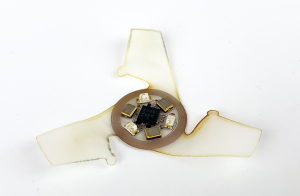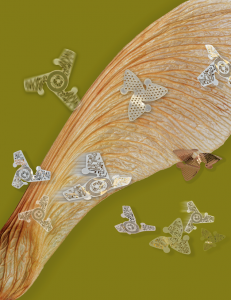Northwestern University engineers announced the newest capability of microchips: the ability to fly. The microflier is a grain-of-sand-sized microchip with propellers that are guided by the wind. With this new technology, scientists will be able to, “monitor for contamination, surveil populations or even track diseases.”
The microflier has two parts: electronic components and wings. This makes the microchip low in weight to help prevent it from losing control and chaotically tumbling to the ground. According to the press release, the microflier offers different forms of data collection including: “sensors, a power source that can harvest ambient energy, memory storage and an antenna that can wirelessly transfer data.” It can be made available in various shapes and sizes to accommodate a wide variety of locations. Rogers believes that devices could be mass-dropped from the sky around various locations to “monitor environmental remediation efforts after an oil spill, or to track levels of air pollution at different altitudes.”

“Our goal was to add winged flight to small-scale electronic systems, with the idea that these capabilities would allow us to distribute highly functional, miniaturized electronic devices to sense the environment for contamination monitoring, population surveillance or disease tracking,”said Northwestern’s John A. Rogers. To achieve this goal, the Northwestern research team studied the aerodynamics of a number of plants’ seeds and more specifically the aerodynamics of the wings on a tristellateia seed. This is because tristellateia seeds have bladed wings that make them land in different areas every time. Through trial and error, researchers tested every aspect of these devices based on their seed research from airflow simulation to redesign of the device itself. Eventually, researchers began finding the perfect qualities that allowed the microflier to propagate larger areas efficiently. Propagating is the process of naturally dispersing seeds in order to increase the amount of plants. In this case, propagating is for surveying a large area more efficiently.

In order to combat further pollution of the Earth, Northwestern engineers are developing a version of microfliers that are able to dissolve in water. Right now, the main obstacle is that a majority of these devices may need to be in circulation to keep up with the amount at risk to hit the water.
To learn more about Microfliers and the progress Northwestern researchers are making, check out Northwestern’s press release.
Written By: Kathryn Cottingham
October 6, 2021
Sources:
- https://news.northwestern.edu/stories/2021/september/microflier-winged-microchip-is-smallest-ever-human-made-flying-structure/?&fj=1
- https://www.mccormick.northwestern.edu/news/articles/2021/09/winged-microchip-is-smallest-ever-human-made-flying-structure/
- https://www.sciencealert.com/the-smallest-flying-device-ever-made-by-humans-is-like-a-grain-of-sand
